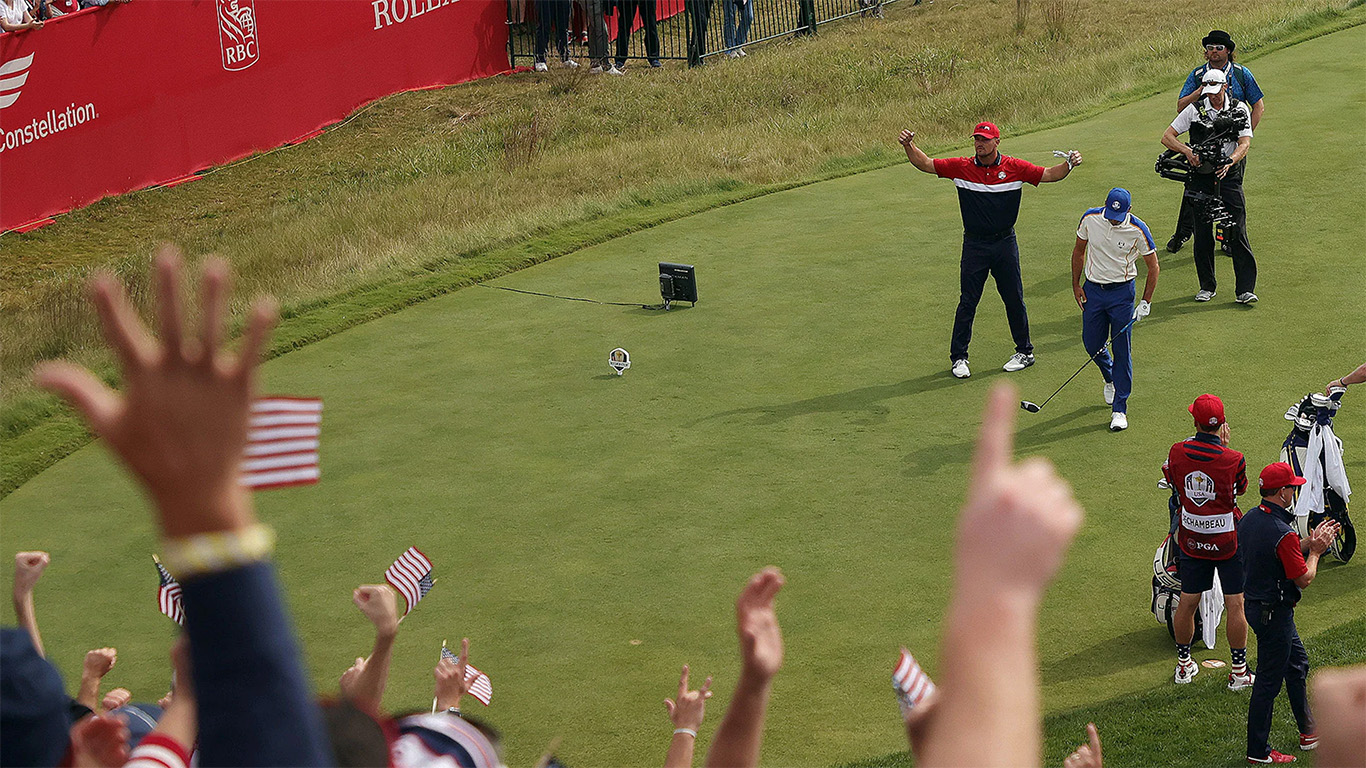As the dust settles on Whistling Straits after the Ryder Cup, one thing is clear: confidence has been restored in Team USA. With a 19-9 victory to its name and plenty of youthful talent in its pipeline, the American side may have a long-term edge in the Ryder Cup for the first time since 1993. Of course, we can’t be sure about anything until, at the very least, the U.S. wins abroad, a feat it will not have accomplished for 30 years by the time 2023 rolls around. So we’ll see.
But in the meantime, after a week of hiking around Whistling Straits and watching as much golf as possible, I have a few thoughts about what I saw.
Bryson, Steph, and the long ball
Bryson DeChambeau drove the 373-yard 1st hole on Sunday. On Friday, he unleashed a 417-yard home run on the 5th, leaving himself a mere 72 yards into the long par 5. But the Bryson bomb from this week that will stick with me was his attempt on Friday to go for the green on the 402-yard 13th.
Watching this moment was NBA superstar and golf nut Stephen Curry. The future Hall of Famer was behind the 13th tee, about five feet from me. After Jon Rahm, Tyrrell Hatton, and Scottie Scheffler teed off, Curry pulled out his phone; he knew he wanted to record what was about to happen. After a quick huddle with Scheffler, DeChambeau withdrew his driver from his bag with a theatrical flourish and pointed it at the sky like a medieval knight brandishing a sword. The crowd went nuts. So did Curry, who mimed the thicc golfer’s sword-pull gesture with his friends.
Then came the shot itself. Bryson went through his Long-Drive-inspired pre-shot routine of hard swings and stepped up to the ball. Immediately after impact, Curry started hooting and hollering and begging for it to reach the green.
All I could think about is whether any other golfer could provoke this kind of reaction from one of the world’s greatest athletes. Maybe Tiger?

Bryson DeChambeau pumps up the crowd on the 1st tee at Whistling Straits (Getty)
Like him or not (and believe me, I understand the “not”), Bryson is the most compelling non-injured player in the game. Watching Steph Curry transform into a 15-year-old golf nerd made me hope that someday DeChambeau will mature and begin to have a truly positive impact on the game.
Where’d it go?
Six months ago, I was informed that with my contact lenses I have better than 20/20 vision. I’ve also spent most of my life watching people hit golf shots. So it’s fair to say I’m an expert at picking up the flight of a ball.
But suddenly, at recent PGA Tour events, I’ve started to have trouble seeing longer hitters’ drives. This issue continued at Whistling Straits. When players hit driver, I often lost track of the ball flight, especially when it was cloudy or unusually bright. So either my eyesight has gone drastically downhill since my last appointment, or the most powerful players’ ball speed is starting to surpass the visible threshold for nearby fans when conditions aren’t perfect.
Sure, a heroic tee shot is exciting, but if you can’t actually follow it, is it that exciting? It’s like going to a basketball game, sitting courtside, and finding that alley-oops happen too quickly to see. Kind of disappointing!
A common argument against rolling back golf equipment is that we don’t want to lose the spectacle of long drives. But if the ball is traveling too fast for most fans to pick it up, doesn’t that mean the pro game has become less fun to watch? If we rein in ball speed, longer players will still be longer than their competition, and the rest of us might be able to follow their shots.
Bryson’s drive on the 13th hole on Friday was amazing not because 373 yards is the magic number at which golf shots become cool; it was because he was the only player who could reach that green. The hole could have been 330 yards, and with rolled-back equipment, the effect would have been the same. Except maybe we would have been able to see the ball flight.
The distance difference
In the run-up to this Ryder Cup, analytics experts agreed that distance off the tee would be an asset to an unusual degree at Whistling Straits. They were right. The U.S. was the longer team, stacked from top to bottom with elite drivers of the ball, and not surprisingly, the Americans feasted on the Straits Course’s three par 5s. Over 28 matches, they won 35 par 5s in 79 chances (44%). Europe won 12.
Strong par-5 performance is an indicator of tidy golf. It requires long, accurate shots off the tee and from the fairway. So the fact that the Americans outperformed the Europeans by nearly triple on the par 5s last week shows how much better they were at ball-striking.
This advantage was obvious on short par 4s, too. In all five sessions, I watched at least one group play the 361-yard 10th hole. The longer players loved this tee shot, with the fairway swinging from right to left along a ridge and providing plenty of room to the right. Since most of Team USA’s big hitters play a fade, they could swing freely and not fear the right miss. But when they caught hold of one, they were able to push the ball up near the green. Meanwhile, shorter players had to hedge cautiously out to the right.

The 10th hole at Whistling Straits. Photo: Andy Johnson
What I saw over and over on No. 10 was the value of 20 extra yards off the tee. Those who had a full wedge in were happy to leave themselves with a 15-foot birdie putt. But the players who could get their tee shots close to the green—often the Americans—would answer by hitting a chip to five feet. Poor chips ended up about the same distance from the hole as the good full wedges. The result: the U.S. squad won the 10th hole 11 times to the Europeans’ five.
Wait, bunkers are hazards?
The telecast mentioned many times that the 2015 PGA Championship at Whistling Straits produced the lowest up-and-down percentage from bunkers of any tour event on record. At the Ryder Cup, we once again saw the world’s best golfers struggle out of the sand. Why?
The obvious reason is that many of the bunkers are deep, small, and wildly shaped, creating a variety of difficult, awkward lies. The less obvious reason has to do with the sand itself.
The bunkers at Whistling Straits are exposed to a lot of wind, which means sand blows out of some bunkers and into others. This inconsistency has a noticeable effect on the pros, who are usually sand-save machines. They end up being more cautious and tactical with their approach shots, and viewers, sensing the raised stakes, move to the edge of their seats. When a ball skirts the edge of a bunker, it’s actually suspenseful.

The 14th green at Whistling Straits and its treacherous surrounds. Photo: Andy Johnson
So my takeaway was that the pro game would be a much better entertainment product if bunkers were true hazards more often. As George Thomas put it, “The spirit of golf is to dare a hazard, and by negotiating it reap a reward.” This dynamic works only if the hazards instill genuine fear.
A changing of the guard for Europe
Was last week the end of a European dynasty? Prior to Whistling Straits, Europe had won nine of 12 Ryder Cups. But today, the stalwarts of the past several European teams are in their 40s. We may see Sergio García and Paul Casey make one or two more appearances, but their contemporaries are on their way out. This doesn’t mean the team will be worse; it will just be different. And the most different aspect of future European squads may be where the players come from.
Ever since Team Europe came into existence in 1979, it has been anchored by a stout group of Englishmen. Lee Westwood, Paul Casey, Ian Poulter, Justin Rose, and Luke Donald have been fixtures in the 21st century, and various other English golfers have made up the supporting cast. That’s not the case anymore. No offense to Tommy Fleetwood or Matthew Fitzpatrick, but neither can be considered a lock for Rome in 2023.
Fortunately, help is on the way: four of the top 10 players in the World Amateur Golf Rankings are European. But of those four, only one—Alex Fitzpatrick, Matthew’s younger brother—hails from Great Britain.
So for the first time in modern Ryder Cup history, the identity of Team Europe is likely to tilt toward Continental Europe and Scandinavia. Whether Europe will be able to retain its storied camaraderie as this shift occurs remains to be seen. Remember, one of the biggest challenges for the International team in the Presidents Cup has been a lack of chemistry and common culture among its players. The same could be true of the European Ryder Cup team as it loses its English core.
The end of a very brief era for Wisconsin
Say what you will about Whistling Straits and Erin Hills, few U.S. states have one publicly accessible course that can host a major championship or a Ryder Cup, let alone two. But between the PGA Championship’s move to May and the tepid response from players to the 2017 U.S. Open, Wisconsin’s hopes of hosting another men’s major in the next two decades are probably over. I’m not in love with either Whistling Straits or Erin Hills, but it’s tough to argue with the quality of the galleries and visuals from this past week’s Ryder Cup.
Wisconsin has become a true golf mecca in the 21st century, and it deserves the spotlight that only an elite tournament can bring. Erin Hills has the 2025 U.S. Women’s Open to look forward to, but on the men’s side, Wisconsin will just have to hope that the PGA Tour overhauls its schedule (again) and forces the PGA Championship to find another date.


 by
by 
